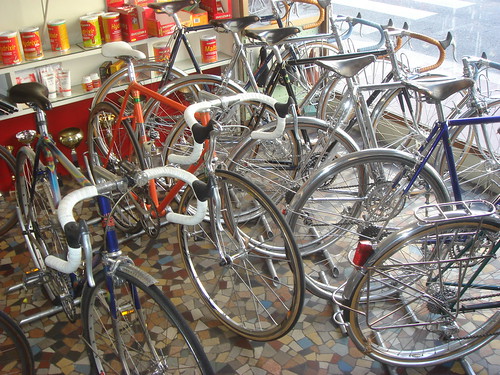When the first diamond frame bicycles became popular in the 1890s they were often called "wheels" - the national cycling association was called the "League of American Wheelmen." We have moved from "wheels" to "bikes," but the bicycles have remained remarkably the same over more than 100 years - elegant in their efficiency and simplicity. And many of the issues that we think are new? They were around then too.
Wednesday, September 15, 2010
Washington Post article - history of bicycles
Monday, September 13, 2010
An American (CA) Delegation Learns from the Dutch
Saturday, September 11, 2010
First "safety" bicycle

There were bicycles with wheels of approximately the same size before this - the main innovation of this bicycle was the use of chain drive to power the rear wheel rather than direct use of the front wheel with pedals on the front wheel's hub.
From the book published in 1945 (but in the public domain), Fifty years of Schwinn-built bicycles.
Wednesday, September 8, 2010
Cycling for Health and Pleasure

Then there is this overly complex (given that it is intuitive) explanation of how to pedal a bike.
In the early days, even for a general audience there was detailed explanation of the mathematics of gearing -nowadays we probably err the other direction with too little.
There is the inevitable guidance on attire, for women in particular.
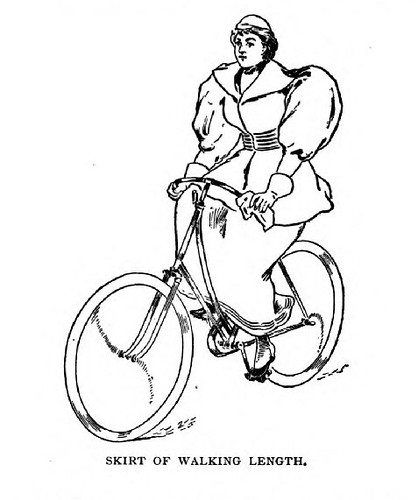
All from Cycling for Health and Pleasure, published in 1895.
Tuesday, September 7, 2010
Lynskey Performance Bike site
Sunday, September 5, 2010
Article about biking with dogs in "Bark" magazine
Saturday, September 4, 2010
The Rider by Tim Krabbé
Sunday, August 29, 2010
The removable tire & inner tube
Thursday, August 26, 2010
Bike racks, parts
Another interesting parts site is bicycleclassics.com even if the web site development work is awful.
Exercise and music (NYTimes article)
In a typical study, from 2008, cyclists who rode in time to music used 7 percent less oxygen to pedal at the same pace as when they didn’t align themselves to the songs.
Wednesday, August 25, 2010
Visit to Davidson Bicycles in Seattle
An example of some of their work ~

There is a Flickr group with photos of Davidson bikes for further perusal.
Epic bicycle journeys - books
Tuesday, August 24, 2010
Philadelphia Bike Exposition
Interview with Jan Heine of Bicycling Quarterly
"It's not something you thumb through once and throw away—each issue is printed on coated card stock, made to archive and re-read for years to come." (About Bicycle Quarterly)
Sunday, August 22, 2010
"Wheel flop" and other such terminology
What makes a bike handle beautifully does a good job of explaining wheel flop, rake, offset, and other terms.
The Bicycle Quarterly glossary comes at this from a different (and also helpful) direction.
Friday, August 20, 2010
Bike parking at Pike Place Market

Bike parking at Pike Place Market
Originally uploaded by Michael Neubert
I assume this style of parking of bikes at the Pike Place Market in Seattle is intended (to some degree) as a rebellious statement. It certainly doesn't seem very convenient. At any rate, the bikes lined up nicely for the photo.
Thursday, August 19, 2010
2009 Speedvagen Road
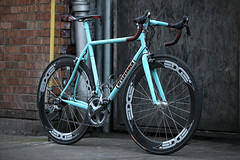
2009 Speedvagen Road
Originally uploaded by Vanilla Workshop
Speedvagen bikes are in the "Bespoked" book (really an exhibit catalog) I just bought. Very nice!
Ballard locks & bikes
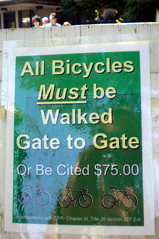
Ballard locks & bikes
Originally uploaded by Michael Neubert
Since the locks are a federal facility, the federal Code of Federal Regulations (CFR) is cited as governing the walking of one's bicycle at the Ballard locks.
Common sense suggests the same thing but it seems reasonable I suppose to make this point more clearly.
Wooden frame bikes (Renovo)
It's the smoothest bike you'll ever ride, stealth quiet, lightweight and responsive, stiff as you want. Renovo hollow wood and laminated bamboo frames will forever change your understanding of what a bicycle should be, and how brilliantly these natural materials perform when designed to their strengths.
Bespoke: The Handbuilt Bicycle (exhibit)
The online version of the exhibit with more photos.
Monday, August 16, 2010
Huffy racing bike
Hampsten's steed back then was a prototypical road racer of the late '80s with a lugged steel frame and fork, a 1in threaded steerer and shifters that were mounted on the down tube, not conveniently integrated into the brake levers. But the characteristics he sought from his machine back then aren't far off what racers demand today.
Photo gallery of this steel bike
LA mayor changes view on cycling
Sunday, August 15, 2010
Mountain biking park, under I-5, Seattle
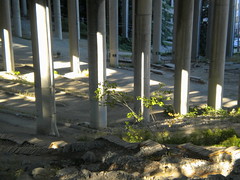
Mtn biking park, under I-5
Originally uploaded by Michael Neubert
This park was written about in the NYTimes a while ago - it seems to have been added to since last summer. ((Link to NYTimes article from here.) Pretty elaborate riding experience possible, right in the middle of the city. (Noone here when I photographed it since it was like 8:45 Sunday morning.)
Warning sign makes it clear that this is at your own risk. The recommendation that one wear "body armor" seems a little extreme.
Saturday, August 14, 2010
How to cross RR tracks in Ballard
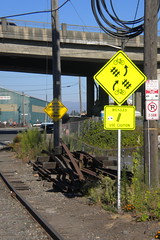
Track crossing guidance
Originally uploaded by Michael Neubert
Somewhat complicated signage to keep cyclists from hurting themselves while crossing railroad tracks in Seattle.
Friday, August 13, 2010
The Competition Bicycle
Wednesday, August 11, 2010
NYTimes article on Google maps for Cyclists
While cyclists say all this bike-mapping software is handy for planning trips, most agree it is more useful as a Plan B than a Plan A, which should be just a normal, fold-up bike map. “I never would rely on it 100 percent,” said Mr. Maus of Portland, Ore. “Just as I wouldn’t only rely on car directions from GPS. It’s not as smart as a human being on the ground.”
Tuesday, August 10, 2010
Univega Superstrada

Univega Superstrada
Originally uploaded by Michael Neubert
Steel used bike that has been refurbished (restored?) rented for 2.5 weeks from Recycled Cycles in Seattle.
Set of photos of the bike on Flickr.Strictly speaking at 54 cm this is a little small, but the distance from end of saddle to the front of stem is OK and this was the best (really only) choice. I am comfortable riding it, so that seems like the big thing.
Some research suggests that this is something like a 1998 or 1999 model, frame made in Taiwan. (Earlier Univega steel frames were made in Japan, apparently.) The bike has mostly 105 components - the drive train is entirely 105 but the brakes are RSX (a lower component grade) and having both on one bike seems peculiar. The info I see shows that from 1995-1997 the Superstrada has all RSX. Hm. Also, the 97 model was shown with seven rings in back and this has eight, so again I'm thinking this is a later model than 97. But in 2001 the brand disappeared, so no later than that!
The back wheel appears to be original but the front wheel is new. Odd that the back wheel would outlast the front wheel. The paint has been touched up in a few places but generally for a bike more than ten years old, I don't think this was ridden that much.
The metallic flake burgundy paint job is not something I would probably choose but one gets used to it. The extemely strange lettering used for the "Univega" brand name is a peculiar choice - does it help with marketing to make the name of the company impossible to read??
Sunday, August 8, 2010
What to ride in Seattle?
Will have to investigate further.
Friday, August 6, 2010
Bike and dingy
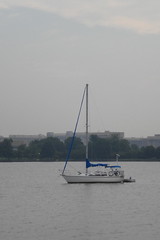
Bike and dingy
Originally uploaded by Michael Neubert
In this way one could bicycle anywhere, land or sea.
Wednesday, August 4, 2010
Two women with bicycle, around 1900
On verso of image: A tea party in the garden of an early Hoquiam home.
Bike is typical of the period - identical to the design of a man's bike but has the low top bar. Also, has a back fender that is covered with a mesh to keep skirts out of the spinning wheel.
From the University of Washington digital collections.
Classic book of early cycling
The weight of roadsters varies between thirty-fiveSixty pounds! Wow ~
and sixty pounds, and of racers between twenty and
thirty-five pounds. The diameter of front wheel
ranges from forty to sixty inches, —forty-eight, fifty,
fifty-two, and fifty-four inches being the most com-
mon sizes ; and the wheel is chosen to fit the rider
as pantaloons arc, —according to length of leg, &c.
The whole is made in form and finish, lines and pro-
portions, with a view to comely appearance as well
as utility, and, when mounted by an accomplished
rider, is remarkably handsome.
From HathiTrust - digitized by Google at the University of Michigan.
Cycling in DC - 1912

Title: Wilbur H. Woodward, 428 Third St., N.W., Washington, D.C., Western Union messenger 236, one of the youngsters on the border-line, (15 yrs. old) works until 8 P.M. only. Location: Washington (D.C.), District of Columbia.
From the Library of Congress Prints & Photographs online catalog.
Monday, August 2, 2010
Parking Garage - Trailer with Two Bikes
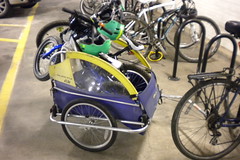
Parking garage - trailer with two bikes
Originally uploaded by Michael Neubert
OK, so this is the first time I have seen this - the guy used to have a trail-a-bike built for two kids, now he has two 16 wheel bikes he hauls in a bike trailer after the kids are dropped off at day care. (It's hard to see in this photo, but there are two bikes there - you can see the two green helmets, anyway.)
Surreal.
Sunday, August 1, 2010
Traitor Ruben - Photo on Flickr
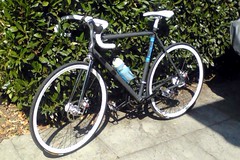
Traitor Ruben - new cycle
Originally uploaded by Michael Neubert
This, oddly, is my most viewed photo on Flickr even though it is low res from a cell phone camera. I bought this bike in August 2009 in Seattle to use as a commuter bike here in Arlington (Virginia). Slightly surprising assortment in the group on an steel frame. Ultegra brake levers/shifters, 105 in the back, FSA compact crank in the front, Avid road disk brakes, Nitto road handlebars.
And yes, the seat post, seat, handlebar tape, hubs and rims are all white (or were, when I bought it - the handlebar tape and seat have changed . . . ). The spokes are black and the frame is a dark grey. The lugged steel fork is chrome (no paint).
I replaced the pedals with cages with better pedals when I got home (Arlington).
The Traitor site has photos showing more details, but the version shown there doesn't have a front derailleur and has a single bar-end shifter. Also they have made some small changes since I bought mine.
I really should take some better photos to make available.
Cycle travel
Flickr Blog Entry - Bikes in Amsterdam
The Bicycle: It's Selection, Riding and Care (1892)
Below we see the "incorrect" position for riding a bike, according to this book. Perhaps the fellow is simply having too much of a devil-may-care time??
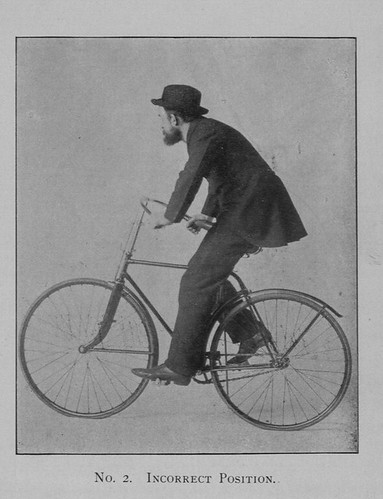
Here is the "correct" position ~
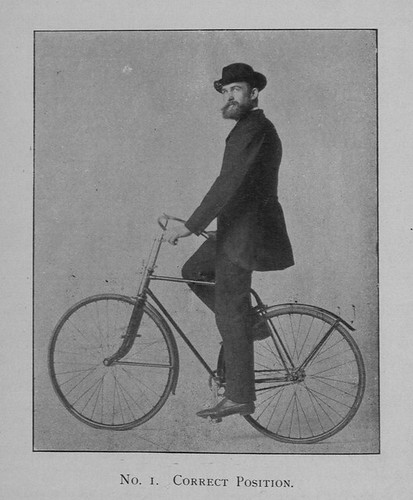
Major Taylor's story
Wikipedia's article on Major Taylor notes that, "Taylor was the first African-American athlete to achieve the level of world champion and only the second black man to win a world championship—after Canadian boxer George Dixon."
Saturday, July 31, 2010
Bike Park under the Freeway in the Middle of Seattle
United Bicycle Institute
One learns: Frame Geometry, Frame Fit, Frame Design, Tubing Selection, Shop Safety, Tool Selection & Use, Brazing, Equipment Setup, Jig Setup & Use, Tube Mitering, Tube Prep, and Finish Work.
Portland class schedules & Ashland class schedules.
Spaldings Official Bicycle Guide for 1899
The "advice" seems to find much wrong with the person receiving the advice, sight unseen. For example, on the subject of "Why Chains Often Break" we read:
The reasons for this trouble are various, but tradesmen hold to the
opinion that it is mostly the chains on cheap wheels which have been
neglected all winter that break in the spring. They are rusty and
worn, and consequently weaker than they were. When taken out on
the road without being cleaned or adjusted the dust gets in them and
tightens them up so that an extra strain is imposed, under which they
part. Another cause is the erratic pedalling of riders who have never
learned how to properly manipulate their feet on a bicycle. The top
stretch of the chain is allowed to slacken and is then tightened sud-
denly by a violent thrust. Then it snaps.
So if your chain breaks, it is because you bought a cheap bike and then didn't take good care of it as well, so it's all your fault.
1900 Columbia Bike (or Wheel . . . ) catalog
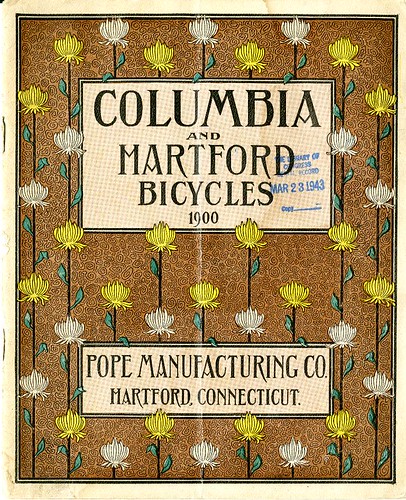
One thing that has changed is that at that time "chainless" drive was considered to be the new advanced approach (with a drive shaft, rather than chain). The bikes in this catalog with shaft drive cost significantly more, and although it wasn't apparently possible to discern this at the time readily, were less efficient, so perhaps it is not surprising that it never really caught on.

From time to time different companies try to revive "chainless" bikes with shaft drive, but as long as the main power source is the rider, it seems unlikely to catch on. (Perhaps when bikes with powered assist are more common it will do better.)
Wikipedia has a description of chainless bikes that covers the subject pretty well.
Page turner presenting full 1900 catalog of Columbia bikes
Bike commute home

Following a rider using a carbon fiber leg, steel one-speed bike
The Paterek Manual for Bicycle Framebuilders
Paterek.com provides the ability to purchase the new third edition.
Paterek Manual is a PDF of the first edition, which he has made available apparently because Paterek was annoyed that a Russian pirate was offering it.
One of my favorite bits so far is the guidance for the distance from the front end of the saddle to the front of the stem is "one cubit" - which is the distance from the elbow to the end of the fingers (and specific to an individual, naturally).
